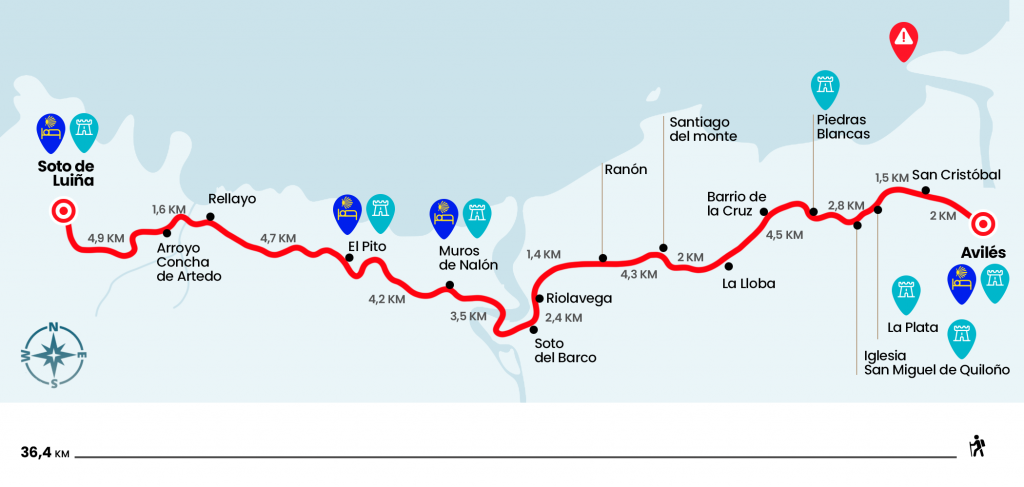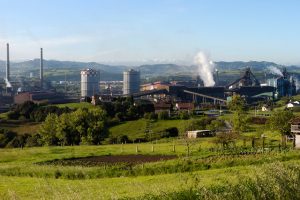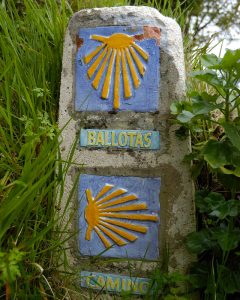Article translated by an automatic translation system. Press here for further information.
Stage from Avilés to Soto de Luiña
Demanding stage of "breaking legs" when crossing villages and hermites
Information about the stage 22: Stage from Avilés to Soto de Luiña

Enlarge map
Points of interest in the stage 22: Stage from Avilés to Soto de Luiña
The route
The urban route of Avilés: Calle Rivero, Parque del Muelle, Barrio de Sabugo, Plaza del Carbayo, Avenida de Germany, costs from San Cristobal and then arrives at Campo del Conde, at this point at the crossing, facing the left, later about 150 mtrs. to the right by Calle Peñasanta, continuing about 200 mtrs., we took a small road to the left where we found a cairn and signaling, entering the beginning of the Camino as it passed through the Council of Castrillón that heads to Piedras Blancas through La Plata. We continue along this wooded road with old road and tunnel of trees in soft descent, crossing a stream and a fountain with laundry , to continue to La Plata, another cairn when arriving at the AS-320 in this town and follow Piedras Blancas by road, bordering the Castro de La Armada (a path has been requested for this section) and leaving to our left the Church of San Miguel de La Armada. All in front to pass through a tunnel, in the area of El Ventorrillo (old inn and sale), linking with another path that leads us to Piedras Blancas. It is followed up to the City Hall, capital of the Council of Castrillón, on its urban route (Fruela Streets and Pablo Iglesias) and Church of Santa Maria Madre de la Iglesia in the center and leaving the Ayto. by its right (Calle Nuberu) to the Villar, then to the left by the track going to the Sierra del Cordel, by El Muro and La Lloba from where it descends to La Ventaniella (Santiago del Monte), passing through its Church. Cross the road that goes to Asturias airport, with attention to traffic, then link to the road that goes to Ranón(AS-318). After a couple of kilometers and at a junction, get off this road by a road through the forest to the left that leads us down the mountain near the village of Riolavega. We continue west towards the Boat Soto Council and descend towards the road of San Juan de la Arena. It goes up to the hamlet of El Castiello and goes to the right entrance of Soto del Barco along a route next to the Hotel Palacio de la Magdalena, with less traffic, to cross the bridge over the Nalón by the national road. On the other side you take the road to Era (left of the N-632) and go up to the capital of the Council of Walls of Nalón, passing past its City Hall.
From the Plaza de Muros de Nalón we leave, passing by the Palace of Valdecarzana and Vallehermoso, towards El Pito and its Selgas Palace in the Council of Cudillero. The Camino does not pass through Cudillero, one of the most picturesque fishing villages in Asturias, only a few kilometres away. He heads to Rellayo. Important warning: The works of the A-8 have quite blurred the section between El Pito, San Juan de Piñera and Rellayo, the signaling forces to give a rodeo that passes through Mount Santa Ana. The official Camino recovers in the tunnel that saves the N-632 and that plants us next to the Mariño hotel. We descend to the vicinity of the beach Concha de Artedo, we save a stream and we go back to the national to cross it and go, on a paved runway and down a road down La Magdalena, Otero and Numayor, to give with the old N-632, through which we enter Soto de Luiña, where La Iglesia de Santa María stands out.
The difficulties
Remarks
In images
What to see, what to do
The hostels

¿Do you want to send any photo of "The Camino de Santiago"?
If you have any photos of "El Camino de Santiago" that you want to share with us, you can send them to us and enlarge the photo gallery


Forum: What pilgrims think about the Camino de Santiago
See all